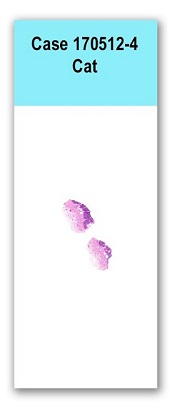Case 4 170512
Conference Coordinator: Molly Liepnieks
//
Fourteen-year-old, male, castrated domestic medium-haired cat.
Approximately four months prior to submission of this biopsy. the owner of this cat noticed an crusted lesion on the skin between the scapula. A fine-needle aspirate of the draining tract identified neutrophils, cocci, and intracellular rod-shaped bacteria. Gram negative rods were cultured but the species of bacteria was not provided.
A 6-mm-diameter punch biopsy sample was submitted from the affected area of skin. No significant gross lesions were reported in the small sample.
Two sections of haired skin are examined in which the dermis is focally expanded by a multilobular, densely cellular, well-demarcated, expansile, unencapsulated neoplasm. Neoplastic cells form dense nests and lobules separated by fibrous connective tissue. Cells are round to fusiform with indistinct cell borders, scant to moderate eosinophilic cytoplasm, and large ovoid nuclei that are variably hyperchromatic. The neoplastic cells are frequently pigmented. Anisocytosis and anisokaryosis are moderate and there are 39 mitotic figures in ten high-powered fields. One of the lobules contains a central area of necrosis . The surrounding dermis is infiltrated by small numbers of lymphocytes and plasma cells. The overlying epidermis is variably acanthotic, spongiotic, hyperkeratotic, and focally ulcerated. Small regions of hemorrhage are present overlying the epidermis. Portions of hair follicles deep to the mass are distended by loose keratin debris.
No special stains.
Haired skin, dorsum: basal cell carcinoma
This small basal cell carcinoma (BCC) appears to have been completely excised within the punch biopsy, albeit with narrow margins.
Basal cell carcinomas were previously thought to derive from adnexal rather than epidermal tissues. However, better morphologic and immunohistochemical characterization have excluded desmoplastic trichoepithelioma, ductular sweat gland neoplasms, and trichoblastoma from the basal cell carcinoma category.
Basal-cell carcinomas and hair follicle tumors share many markers including cytokeratins 5, 6, 10, 14, 15, 16, 17, and 19 in various combinations. Immunohistochemistry for cytokeratin 15 and cytokeratin 19 have been negative or limited in BCCs in some studies. Cytokeratins 8, 13, and 7/8 are good markers for sweat gland tumors. Antiapoptotic protein, bcl-2, can be identified in most BCCs and immunohistochemistry for BerEP4 is positive in all. However, these are variably positive in hair follicle tumors but negative in squamous cell carcinomas. These markers are well-established in human medicine; however, keratin profiles are not fully established for feline or canine BCC.
Chronic exposure to ultraviolet light is a key factor in the induction of BCCs in humans. However a causal link between sun exposure and BCC in dogs and cats has not been established. In cats, BCCs frequently coexist with actinic keratosis and squamous cell carcinomas. Pathogenesis is unknown in dogs.
There are three primary variants: solid, keratinizing, and clear cell. Solid BCCs are most common in cats, while keratinizing BCCs are more common in dogs. Tend to occur in older animals and the incidence of recurrence and metastasis is very low.
There are three primary variants: solid, keratinizing, and clear cell. Solid BCCs are most common in cats, while keratinizing BCCs are more common in dogs. Tend to occur in older animals and the incidence of recurrence and metastasis is very low.
Silhouette is a key diagnostic feature. The BCCs tend be horizontally oriented, almost plaque-like. Oil red O can be used to differentiate poorly differentiated sebaceous tumors from BCC.
Gross TL, Ihrke PJ, Walder EJ, Affolter VK. 2010. Skin diseases of the dog and cat: clinical and histopathologic diagnosis. John Wiley & Sons.

